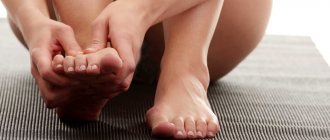Save article:
The article explains:
- General description of carpal tunnel syndrome
- Types of tunnel syndrome
- Symptoms of carpal tunnel syndrome
- Causes of carpal tunnel syndrome
- Doctors who help with carpal tunnel syndrome
- Diagnosis of carpal tunnel syndrome
- Treatment of hand tunnel syndrome
- Medications for carpal tunnel syndrome
- Exercises for carpal tunnel syndrome for prevention
Do you notice that your hands ache more and more often, your fingers become stiff, and movements become more and more difficult? You have carpal tunnel syndrome, most likely this is the problem. Today it is becoming a problem for many people who spend a lot of time at the computer. But don’t rush to draw conclusions, read our article first.
From it you will learn about this disease, its varieties, symptoms and, most importantly, causes. We will also tell you which doctors you can contact for help and how the treatment is carried out. At the end of the material you will find useful exercises that will help you prevent this syndrome yourself. Read carefully and be healthy.
General description of carpal tunnel syndrome
Carpal tunnel syndrome can occur when the median nerve in the wrist is compressed and is characterized by certain symptoms. This disease is listed in ICD-10 under code G56.0.
Among the characteristic symptoms, numbness in the hand, paresthesia, and pain in the area of innervation of the median nerve should be noted. Symptoms may also affect hand sensation and strength.
The syndrome develops as a complication of diseases of various origins or as a consequence of ligamentous and ligamentous overstrain that occurs around nerve fibers. In this case, the nerves are either compressed or stretched. The median and ulnar nerves are most often affected. The latter, in turn, can be pinched in the joint area or on the wrist inside Guyon's canal.
General description of carpal tunnel syndrome
There are several types of tunnel syndrome, depending on the degree of participation of anatomical structures in the development of pathology. To date, experts have identified 30 such options.
Clinical manifestations
With the development of pronator teres syndrome, the patient complains of pain and burning 4–5 cm below the elbow joint, along the anterior surface of the forearm and pain radiating to the 1st–4th fingers and palm.
Tinel's syndrome. In case of pronator teres syndrome, Tinel's sign will be positive when tapping with a neurological hammer in the area of the pronator snuff box (on the inside of the forearm). Pronator-flexor test. Pronating the forearm with a tightly clenched fist while creating resistance to this movement (counteraction) leads to increased pain. Increased pain can also be observed when writing (prototype of this test). When examining sensitivity, a sensitivity disorder is revealed, involving the palmar surface of the first three and a half fingers and the palm. The sensory branch of the median nerve, innervating the palmar surface of the hand, usually passes above the transverse carpal ligament. The occurrence of sensory disturbances on the palmar surface of the first finger, the dorsal and palmar surfaces of the second and fourth fingers, with preservation of sensitivity in the palm, allows one to confidently differentiate carpal tunnel syndrome from pronator teres syndrome. Thenar atrophy in pronator teres syndrome is usually not as severe as in progressive carpal tunnel syndromes.
Types of tunnel syndrome
The syndrome can manifest itself in several generally accepted forms.
- In the median nerve:
- carpal tunnel syndrome (carpal tunnel, carpal tunnel);
- pronator syndrome (Seyfarth syndrome, “newlywed (honeymoon, lovers) paralysis");
- supracondylar syndrome (Coulomb, Lord and Bedosier syndrome, Straser's band syndrome).
- In the ulnar nerve:
- Guyon's syndrome (Guyon's bed syndrome, ulnar carpal syndrome, compression-ischemic neuropathy of the distal part of the ulnar nerve);
- cubital syndrome (ulnar tunnel syndrome, compression neuropathy of the ulnar nerve in the cubital canal, late ulnar-cubital traumatic palsy).
- In the radial nerve:
- syndrome of compression of the radial nerve in the armpit (“crutch paralysis”);
- syndrome of compression of the radial nerve in the middle of the shoulder (spiral canal syndrome, “Saturday night paralysis”, “park bench”, “bench” syndrome);
- compression syndrome of the radial nerve in the subulnar area (“tennis elbow”, compression neuropathy of the posterior branch of the radial nerve in the subulnar area, supinator syndrome).
Clinical manifestations
The full picture of tunnel syndrome includes sensory (pain, paresthesia, numbness), motor (decreased function, weakness, atrophy) and trophic disorders.
Various clinical course options are possible. Most often it starts with pain or other sensory disorders. Less commonly, it begins with movement disorders. Trophic changes are usually expressed insignificantly and only in advanced cases. The most characteristic feature of carpal tunnel syndrome is pain. Typically, pain appears during movement (load), then occurs at rest. Sometimes the pain wakes the patient up at night, which exhausts the patient and forces him to see a doctor. Pain in tunnel syndromes can include both a nociceptive component (pain caused by inflammatory changes occurring in the area of the nerve-canal conflict) and a neuropathic component (due to nerve damage). Tunnel syndromes are characterized by manifestations of neuropathic pain such as allodynia and hyperpathy, a sensation of electric current passing (electrical shooting), and burning pain. In later stages, pain may be due to muscle spasms. Therefore, when choosing pain therapy, it is necessary to be guided by the results of a thorough clinical analysis of the characteristics of the pain syndrome. Motor disorders arise as a result of damage to the motor branches of the nerve and manifest themselves in the form of decreased strength and rapid fatigue. In some cases, the progression of the disease leads to atrophy and the development of contractures (“clawed paw”, “monkey paw”).
With compression of arteries and veins, vascular disorders may develop, which is manifested by pallor, a decrease in local temperature, or the appearance of cyanosis and swelling in the affected area. With isolated nerve damage (in the absence of compression of arteries and veins), trophic changes are most often insignificantly expressed.
Symptoms of carpal tunnel syndrome
The development of symptoms of this disease occurs gradually. The syndrome first makes itself felt at night or in the morning when a person wakes up. This is expressed in the patient's irresistible desire to shake his hands. A person can experience this state at night, and many times.
The syndrome manifests itself mainly:
- pain;
- numbness;
- tingling.
Free online intensive
Your Path to IT starts here
More details
On the hand, such manifestations occur in the thumb, index, middle fingers and half of the ring finger. Sometimes symptoms are felt throughout the entire arm, reaching up to the forearm.
A person may experience painful and unpleasant sensations throughout the day if the syndrome begins to progress. In this case, loss of strength in the hand is possible. It becomes more difficult for the patient to clench his hand into a fist or grasp small objects. Problems can also arise when you need to open a bottle, fasten a button, or type text on a computer.
Without treatment, there is a risk of muscle atrophy at the base of the thumb. This in turn will lead to a loss of the ability to sense heat and cold with the thumb and forefinger.
Symptoms of the disease may appear or intensify after the patient uses the affected arm. But even keeping the hand or the entire arm in one position for a long time can lead to tingling, burning and pain.
Clinical manifestations
Carpal tunnel syndrome is characterized by pain, numbness, paresthesia and weakness in the arm and hand.
Pain and numbness extend to the palmar surface of the thumb, index, middle and 1/2 ring finger, as well as to the dorsum of the index and middle finger. Initially, symptoms occur when performing any activities using a brush (working on a computer, drawing, driving), then numbness and pain appear at rest, sometimes occurring at night. The following tests are suggested to verify the diagnosis of carpal tunnel syndrome. Tinel test: tapping the wrist (above the median nerve) with a neurological hammer causes a tingling sensation in the fingers or pain radiating (electrical shooting) to the fingers (Fig. 2). Pain may also be felt in the tapping area. A positive Tinel sign is found in 26–73% of patients with carpal tunnel syndrome [Al Zamil M.H., 2008]. Durkan's test: compression of the wrist in the area of the median nerve causes numbness and/or pain in the 1st–3rd, half of the 4th fingers (as with Tinel's symptom). Phalen Test: Wrist flexion (or extension) 90 degrees produces numbness, tingling, or pain in less than 60 seconds (Figure 3). A healthy person may also develop similar sensations, but not earlier than after 1 minute. Opposition test: with severe thenar weakness (which occurs at a later stage), the patient cannot connect the thumb and little finger (Fig. 4); or the doctor (researcher) can easily separate the patient’s closed thumb and little finger.
Causes of carpal tunnel syndrome
Certain areas of the brain and spinal cord are responsible for receiving information and transmitting commands to muscles and receptors. Information is transmitted to internal organs via nerves. Most of the peripheral nervous system has protective properties that protect it from physical damage:
- wave-like movements of unstressed nerves;
- elasticity of nerves;
- the location of the nerves near the joints, eliminating excessive stretching during the movement of the limbs.
Muscles, ligaments, tendons and parts of the human skeleton form natural tunnels in which the nervous system is located. If these anatomical cavities become excessively narrow, there is a predisposition to tunnel neuropathy. In this case, not only the nerves themselves can be compressed, but also all the vessels running along the nerve trunks. In such cases, neurovascular tunnel syndrome occurs.
Nowadays, activities involving prolonged static load are widespread. Office workers, IT specialists, artists, musicians and athletes, to name a few, perform much of this monotonous work. And the increase in cases of tunnel syndrome is a consequence of this situation on the labor market.
Basically, pathology in people occurs due to overstrain of the ligaments and muscles located near the affected nerve. In approximately 80% of cases, the upper extremities are affected.
Materials from the closed collection of GeekBrains on achieving an income of 150,000 ₽ remotely
Do you want to earn more or work remotely? Confused by the variety of professions and don’t know where to go?
The GeekBrains team, together with career experts, have prepared documents that will help you find and choose an in-demand, highly paid profession.
Alexander Sagun
Chief career consultant
Download and use today:
Job search channels
List of 26 resources and 34 Telegram channels
Top 30 most in-demand and highest-paid professions 2022
Rating of the most relevant specialties in 9 areas
Typically, documents are only available to Career Workshop students, but we decided to share them with you for free!
Download and take the first steps towards your dream job or business!
A previous infection (most often viral) can also be accompanied by peripheral neuropathies of a post-traumatic nature or cause complications in the form of these neuropathies. This is the second most common cause of carpal tunnel syndrome.
Among other diseases in which neuropathy is often observed, it is worth noting diabetes mellitus, acromegaly, gout, rheumatoid arthritis and other joint problems, voluminous pathologies of the nerves themselves (neuroma, schwannoma), sarcoma, lipoma.
Causes of carpal tunnel syndrome
A significant role is played by a hereditary predisposition to paralysis from compression of nerve fibers and hormonal changes in the body against the background of ovulation, lactation and menopause. Finally, the risk of the syndrome increases with the use of oral contraceptives.
The function of the peripheral nervous system can be impaired due to injury, ischemia (primary or resulting from compression), stagnation of blood in the veins and tissue edema.
What happens when a nerve is compressed?
The blood supply to the outer sheath of the nerve slows down and blood stops flowing. This condition is called ischemia. At first, the outer shell of the nerve is affected, but as pressure increases, its inner part becomes thicker, as new cells - fibroblasts and scar tissue - are formed.
As a result, the patient feels pain and the hand becomes numb. When the pressure normalizes, the symptoms quickly subside. In the absence of timely treatment, the chances of recovery are reduced or lost.
Diagnosis of carpal tunnel syndrome
Usually, to make a diagnosis, the doctor needs to know the characteristic symptoms of the patient. In this case, it is convenient to use a set of special tests that make it possible to identify different types of tunnel neuropathies.
A package of closed documents from GeekBrains paid courses
Alexander Volchek
Head of IT Training
Together with career building experts, we have prepared documents that will help you make the right choice and determine which IT profession is right for you.
Thanks to these guides, 76% of our students were able to find the in-demand profession of their dreams!
Soon we will remove them from public access, hurry to download for free:
Guide to IT professions
5 professions with skills and average salaries
How to earn from 100 thousand rubles with the help of a new profession
List of 6 popular professions with earnings from 100 thousand rubles
All professions that exist in the IT field
63 professions and the skills required for them
Book recommendations for in-demand professionals
6 areas of activity and useful literature on each of them
Critical mistakes that can ruin your career
We collected 7 common mistakes. Everyone should avoid them!
If a number of signs suggest that a patient has compression-ischemic damage to the peripheral nervous system, standard testing is performed. It includes the following activities:
- general somatic examination with identification of basic vital functions;
- neurological diagnostics using special tests;
- radiography of the affected area to identify additional ribs, bone processes or calluses, fractures, dislocations, etc.;
- neuroimaging using MRI and CT techniques of the affected areas of the nerve trunk, spine, etc.;
- electrophysiological diagnostics using the results of electroneuromyography, which makes it possible to determine the speed of the impulse in the nerve canal and clarify the degree of damage to this nerve;
- Dopplerography of the vessels of the extremities with flexion-extension tests;
- Ultrasound of the affected area, which allows us to identify pathologies that in turn lead to carpal tunnel syndrome.
Also during diagnosis, it is necessary to exclude concomitant somatic pathologies, which are often caused by progressive tunnel neuropathy. To do this, a number of additional examinations are carried out:
- clinical blood test;
- determination of blood glucose levels;
- determination of thyroid-stimulating hormones;
- rheumatoid factor analysis;
- determination of C-reactive protein;
- determination of the antistreptolysin-O indicator;
- analysis of circulating immune complexes.
Prevention of carpal tunnel syndrome
| Attention! All of the recommendations listed should be taken solely as methods of preventing carpal tunnel syndrome, designed to eliminate negative factors affecting your hand and prevent the development of the disease. Although correct hand positioning and ergonomic devices can significantly alleviate symptoms, if you are already experiencing this disease, we strongly advise you to consult a doctor, since only a specialist can prescribe treatment that is adequate for your condition. For example, one of the consequences of prolonged static loads on the wrist is microtraumatization of the tendons, which can lead to such serious complications as aseptic tendinitis (inflammation of the tendon) and tenosynovitis (inflammation of the inner lining of the tendon sheath). In the absence of anti-inflammatory therapy, such conditions are fraught with the appearance of fibrous adhesions and the development of persistent contractures (limited mobility) in the wrist joint, which will subsequently require surgical intervention. |
Basic methods of preventing carpal tunnel syndrome come down to unloading the ligaments, tendons and muscles of the hand by giving it the most physiological position.
So that you better understand what you should strive for, we will conduct a practical educational program on anatomy. Stand in front of a mirror, lower your arms to your sides and relax your muscles as much as possible. Pay attention to the position of your hands: your palms will be facing your hips, at a slight angle.
Now bend one arm at the elbow 90°. Your hand is now in a neutral position . From this position, you can turn it with your palm up (that is, supination of the forearm) or down ( pronation of the forearm). To remember these names, you can use a simple mnemonic rule, known to every senior student at a medical university: “ SOUP - ABOUT lila.” When you carry a bowl of SOUP , your SOUP is inned, that is, turned palm up. But if you make PRO nation by turning your hand palm down, then PRO you are pouring the contents of the plate.
When you use a computer mouse, your forearm is constantly in a state of pronation. Pronator teres (musculus pronator teres) and pronator quadratus (musculus pronator quadratus) are responsible for pronation. During their contraction, the ulna and radius bones cross, the carpal tunnel narrows, and the tendons passing through it are stretched and displaced, compressing the median nerve.
The situation is further aggravated by the incorrect position of the hand on the mouse body: excessive palmar flexion or dorsal hyperextension in the wrist joint, as well as ulnar (outward abduction) and radial (internal abduction) deviation of the hand only increase compression of the nerve trunk. This leads to the first, simplest recommendation.
The hand and forearm should lie on the same line both horizontally and vertically.
The most radical (and expensive) method of solving this problem is to purchase ergonomic furniture or make a custom-made table and computer chair in accordance with your anthropometric data. A more affordable and universal way is to purchase a special armrest for working with a mouse.
This device provides effective support for the forearm and hand, and can be attached to a table top or to the armrest of an office chair. There are also special mats with gel pads, but they are not as effective because they do not provide support for the forearm itself. Therefore, it is advisable to use them only if your workplace is already properly equipped and your elbow does not hang below the level of the tabletop.
We sorted out the “straightening of the arms.” However, to achieve maximum effect, one more important rule must be followed.
Hands should be in a neutral position.
This can be achieved using ergonomic input devices that help reduce pronation. These include, first of all, vertical mice.
The modern market offers a huge number of similar devices for every taste and budget. The most widely used models are those resembling a shark fin in shape (variations on the Logitech MX Vertical theme), but there are also much more exotic modifications, more similar to classic joysticks.
Which device to choose depends purely on your personal preferences.
The main thing is that the mouse provides a natural position for the hand, so that the palm is located on the edge, almost vertically. Trackballs also help relieve stress on the wrist, but only the “right” ones. No matter what the manufacturers say, moving the cursor with the ball itself only helps to avoid microtrauma and compression of the median nerve caused by ulnar and radial deviations of the hand in the horizontal plane, which are inevitable when working with a classic mouse. However, most of these devices, like the Logitech Trackman Marble pictured below, do nothing to solve the problem of forearm pronation.
The same company’s portfolio also includes a much more ergonomic MX Ergo model with an inclined body, which already allows you to reduce pronation and protect your wrist.
However, to achieve the maximum therapeutic effect, this device should be used with an additional stand that increases the angle of the trackball.
With ergonomic keyboards, everything is a little more complicated: although there are many such devices, truly ultimate solutions for the prevention of carpal tunnel syndrome can be counted on one hand. And that's why.
When typing code or text on a regular rectangular keyboard, we immediately encounter two serious problems: firstly, both forearms are maximally pronated, and secondly, our hands are in a state of ulnar deviation, that is, they are retracted outward.
Part of the situation can be improved by dividing the alphanumeric keys into two blocks located at an angle to each other. As you can see in the picture below, this topology of buttons ensures a natural position of the hands relative to the forearms, allowing you to forget about ulnar deviation.
Since each person has unique anthropometric data, such a device will not suit everyone. But there is a more radical solution - buying a keyboard consisting of two halves, which can be easily positioned at the desired angle.
But, alas, you won’t be able to completely get rid of pronation, because to do this you will have to place the button blocks almost vertically, and it will be uncomfortable for you to type. However, even an inclination of 20° will help to further relieve the wrists.
Keyboards, represented by a pair of independent modules, have an advantage here as well, since they allow flexible adjustment of the tilt angle. However, such devices, all other things being equal, are noticeably more expensive.
Now that you have upgraded your workplace, the only thing left to upgrade is your hands themselves. Therefore, our third recommendation will be as follows.
Perform exercises to strengthen the muscles and tendons of the hand and forearm.
There are many myths surrounding exercises to prevent carpal tunnel syndrome. Unfortunately, most “Internet experts” offer a vinaigrette of various exercise therapy techniques aimed at rehabilitating patients who have suffered serious injuries to the hand, wrist joint or forearm, as well as frankly harmful advice in the style of “crack your fingers and say goodbye to the cartilage of the phalangeal joints.” In addition, would-be advisers position such exercises not as a means of prevention, but as a method of treating carpal tunnel syndrome, which is outright sabotage.
| Remember! No adequate doctor would ever prescribe exercises that load the arm to a person with carpal tunnel syndrome during the period of manifestation of the disease. The pronounced clinical manifestations of this disease are, on the contrary, a reason for the application of a splinting orthosis and complete immobilization of the wrist joint for the entire period of exacerbation. |
But what will really help avoid the development of carpal tunnel syndrome?
The correct answer is any exercises aimed at increasing grip strength, because they are the ones that most fully utilize the muscles of the hand and forearm during training. It is almost impossible to develop some general recommendations that will suit everyone: everything will depend on your level of physical fitness. However, there are at least 5 simple and accessible exercises that, when performed regularly, will help strengthen your hand and forearm. 1. Squeezing the expander
The simplest exercise that can be performed even at the workplace. To prevent carpal tunnel syndrome, even the cheapest ring expander made of rubber (in common parlance “donut”) is suitable. As for the load, we recommend purchasing an expander that you can “close” (that is, squeeze all the way) at least 10 times in a row.
2. Finger raises with an elastic band
Another simple exercise that you can do every time you feel that your hand is getting tired and needs to be warmed up. Just put a special fitness band on your fingers (usually they are sold in several pieces of different hardness, so there will be no problems choosing the load) and try to fully open your palm.
3. Bending the wrist with weights
The exercise consists of bending the wrist joint at different angles with additional weights, which can be dumbbells or a barbell. Flexion movements must be performed in full amplitude. Performed with both an overhand and underhand grip.
4. Rotation of the wrist with weights
During this exercise, you need to take a dumbbell in your hand and make rotational movements with your hand in clockwise and counterclockwise directions.
5. Working with a roller
The roller is a handle with a load suspended from it on a flexible cable. The essence of the exercise is to gradually wind the cable around the handle, while keeping your arms extended in front of you and working exclusively with your hands. Performed with both an overhand and underhand grip.
There are also more complex exercises, such as push-ups on the fingers, pull-ups on towels or holding the “silver bullet” (when the trainee holds a torsion expander in his outstretched hand, while holding a sports equipment between its handles, shaped like a bullet, from which a load is suspended) , however, they are all designed for well-trained people. By devoting enough time to training (preferably under the supervision of a professional instructor), you will definitely be able to master them. To prevent carpal tunnel syndrome at first, the five listed above will be sufficient. Cloud servers from MacLeod are fast and secure.
Register using the link above or by clicking on the banner and receive a 10% discount on the first month of renting a server of any configuration!
Treatment of hand tunnel syndrome
There is reliable evidence of the effectiveness of aerobic exercise with body weight control. At the same time, exercise bikes and cycling should be avoided in case of tunnel neuropathy, since here the arms are constantly tense.
Physiotherapy methods (for example, ultrasound treatment) can help relieve symptoms temporarily.
Treatment of hand tunnel syndrome
If electroneuromyography has revealed carpal tunnel syndrome in the early stages, in many cases applying a night splint to fix the hand in a neutral position during sleep is helpful. This procedure must be done for at least three weeks.
Sometimes conservative methods do not allow you to completely get rid of carpal tunnel syndrome. How to treat the disease in this case? An injection of, for example, glucocorticoids with diprospan gives a good effect. In other cases, as well as in severe cases of the disease, surgery is prescribed.
Surgery for compression neuropathy of the wrist involves cutting the palmar ligament that compresses the median nerve. In 9 out of 10 cases, the outcome of the operation is favorable with a minimal likelihood of complications. Moreover, almost always the patient no longer encounters relapses of this disease in the operated area. If, as a result of ENMG, no pathologies were identified, the likelihood of success of surgical intervention is reduced.
Clinical manifestations
The main symptoms of cubital tunnel syndrome are pain, numbness and/or tingling. Pain and paresthesia are felt in the lateral part of the shoulder and radiate to the little finger and half of the fourth finger. At first, discomfort and pain occur only when pressure is applied to the elbow or after prolonged bending. In a more severe stage, pain and numbness are felt constantly. Another sign of the disease is weakness in the arm. It manifests itself as a loss of “confidence” in the hand: suddenly objects begin to fall out of it during some habitual actions. For example, it becomes difficult for a person to pour water from a kettle. In advanced stages, the hand on the sore arm begins to lose weight, and pits appear between the bones due to muscle atrophy.
Medications for carpal tunnel syndrome
To reduce inflammation, patients are recommended to receive corticosteroid injections (usually into the carpal tunnel). Tablets are less effective in relieving inflammation, although they are also available in pharmacies. The effect does not occur immediately - the pain begins to subside only after 2 days, and before that it can, on the contrary, intensify.
But even with a positive result of treatment, symptoms sometimes reappear after a few months. If this happens, a new dose of corticosteroids is prescribed. Subsequent use of these drugs may cause long-term side effects, so further use is not recommended.
Aspirin, ibuprofen and similar non-steroidal anti-inflammatory drugs can reduce short-term pain. Their use is advisable only when the syndrome occurs due to an inflammatory process. If the cause of the disease is excessive activity of the hand, this option will not help.
Other treatment methods include Botox injections and special exercises.










